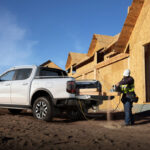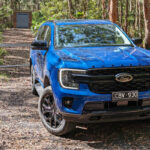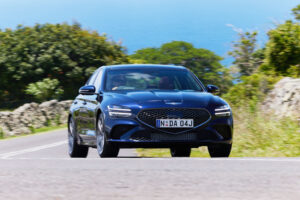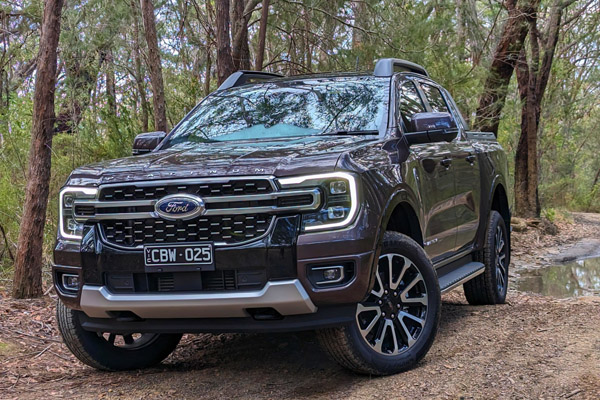
Platinum Ranger is the last stop before you get to the top of the range, the Raptor, which
is almost another $10K plus on-roads.
Dropping back, one gets you the 2.0-litre four-cylinder Wildtrak X, with Platinum
sandwiched between them.
There are so many grades of Ranger these days, with so many special editions to come
when sales start to slow that it’s hard to keep track of them.
The spreadsheet detailing the grades and equipment they come with is mind blowing.
It must be working for Ford, however, because Ranger jumped ahead of the Toyota Hilux
in last month’s figures, to become the top selling car in Australia, with 6215 sales for
October — compared to Hilux’s 5766.
Bringing up the rear in third spot is the Isuzu’s quiet achiever the D-Max with 3198.
STYLING
The look is strong and aggressive, with distinctive “C-clamp” shaped daytime LEDs
leading the way, enhanced in the premium Platinum model by a splash of chrome.
Ranger is priced from $36,380 for the 4×2 2.0 turbo-diesel XL Single Cab chassis with an
auto through to $87,990 for the 4×4 3.0 V6 petrol-only dual cab Raptor, with the 4×4 3.0
V6 turbo-diesel dual cab Platinum coming in at $78,190 — all prices before on-road costs.
You are probably aware the new Volkswagen Amarok shares a platform with Ranger, so it
bears having a look at dual cab Amarok prices which range from $50,990 for the 2.0
TDI405 Core through to the petrol or diesel Adventura for $79,990.
It might look a bit different, but looks very similar inside.
Choose your poison.
Hilux, now in its eighth generation, dates back to 2015 and is starting to look a little long in
the tooth, despite a number of facelifts including the recent GR Sport.
The current, second generation T6 Ranger was launched in 2022. The fact is obviously
not lost on buyers and most likely responsible for the recent spurt in sales.
Ford says new Ranger gives customers the chance to have their cake and eat it too.
They get a serious dose of class and sophistication to go with the inherent capability of the
ute.
Working out what the business class Platinum shares with other grades and what is
actually unique to this model is a challenge.
Exterior enhancements include Platinum badges, black painted roof, chrome trim and a
unique grille, 20-inch alloys with all-season rubber, matrix LED headlights with auto
levelling and dynamic bending, gas damped tailgate and the flexible rack system (FRS).
It’s also available in Equinox Bronze, a colour previously restricted to Everest — but it costs
$700.
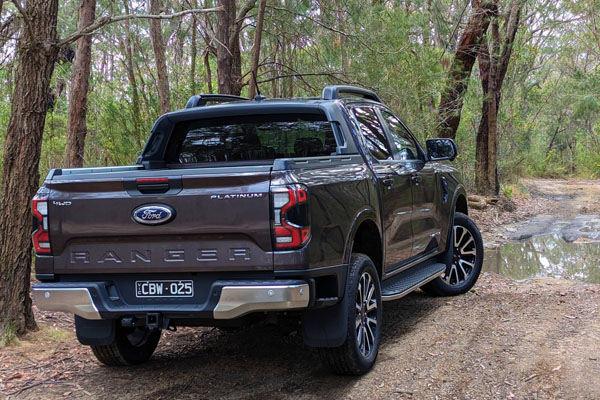
Premium appointments include quilted, leather accented seats and heated steering wheel,
with decorative stitching and other finishes.
The front seats are heated and ventilated with 10-way power adjustment for driver and
front passenger, plus memory settings for the driver.
B&O 10-speaker premium audio and a bank of auxiliary switches have also been added.
Standard kit includes 20-inch alloys, side steps, zone lighting, LED head, tail and daytime
running lights, electric parking brake, keyless entry and start, auto lights and wipers, auto
high beam, speed sign recognition, adaptive cruise control, auto dimming rear view mirror
and front and rear parking sensors and parallel and perpendicular automatic parking.
The tub comes with a light, 12-volt outlet, drop-in tray liner and electrically-operated roller
shutter.
INFOTAINMENT
The cabin is dominated by a huge 12.0-inch Tesla-like portrait touchscreen, with
Bluetooth, voice control, built-in satnav with 12-month connected navigation services,
DAB+ digital radio, both wired and wireless Apple CarPlay and Android Auto plus wireless
phone charging.
There’s USB A + C ports front and back, with a 12-volt outlet in the console box and
another at the rear of the tub.
FordPass app allows you to view vehicle status.
You can also remotely unlock the vehicle, activate zone lighting which turns on all exterior
lights and even start the engine so the aircon heats or cools it down before entry.
ENGINES / TRANSMISSIONS
The four produces 154kW of power at 3750 rpm and 500Nm of torque from 1750-2000
rpm, while the larger single turbo V6 delivers 184kW at 3250 rpm and 600Nm from 1750-
2250 rpm.
Both diesels are paired with a 10-speed auto, with auto engine stop-start and manual gear
changes via a thumb switch setup located at the top of the stubby transmission lever.
It’s not quite as practical as a steering wheel mounted paddles, but better than nothing.
Petrol-only Raptor gets paddles.
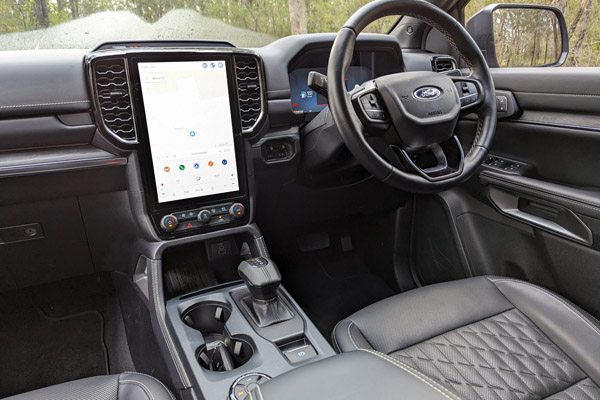
SAFETY
Ranger scores a five-star safety rating with nine airbags, including driver and passenger
knee airbags along with the latest centre airbag which provides added protection to front
seat occupants in side impact crashes is also standard.
There’s also a 360-degree camera, Autonomous emergency braking (Car-to-Car,
Vulnerable Road User, Junction Assist and AEB Backover) as well as a lane support
system with lane keep assist (LKA), lane departure warning (LDW) and emergency lane
keeping (ELK), and an advanced speed assistance system (SAS).
There are two top tether and two Isofix child seat anchors.
DRIVING
Coming from the 2.0-litre four-cylinder twin turbo rear-drive Everest Sport, it was an
interesting transition.
Ute versus SUV, V6 versus four, and 4×4 versus 4×2. They couldn’t be more different.
We didn’t like the ute to start with, but over the course of a week it grew on us.
The ride is firmer and less compliant, but the delivery of power from the V6 is smoother,
more linear and ultimately stronger.
The stubby e-Shifter is a right pain in the butt, with an awkwardly placed shift lock at the
front of the lever.
What’s more, we found ourselves mistakenly clicking the thumb switches to move the car
into drive or reverse.
Like Everest the start button occupies what was the key barrel on the steering column and
takes some getting used to.
Rear-drive Everest has four drive modes in the : Normal, Eco, Tow/Haul and Slippery.
The 4×4 Ranger adds Mud/Ruts and Sand plus a console mounted rotary control for 4×4
selection — 2H, 4H, 4H Auto and 4L.
The 4×4 also gets a rear diff lock.
It’s touted as full-time four-wheel drive, but it’s not really.
Most of the time, drive is directed to the rear wheels.
An electronically-controlled clutch pack handles distribution of torque front and rear rather
than a centre differential.
You can put it in 4H Auto and the transmission will automatically apportion drive to all
wheels if and when it is required.
Performance is strong and the ute gets away from the line surprisingly quickly with very
little turbo lag.
Steering is light around town but weights up nicely on the open road, with plenty of
communication for the driver.
Platinum steps up to a fully digital 12.0-inch driver display with different skins, ranging from
minimal to 4×4 with all sorts of gauges and information.
Selecting between them, however, is not exactly intuitive and it can be difficult to find your
way back to where you want to be.
We were interested to see how the big screen accommodates Android Auto and it aces it,
but we still don’t understand the need for both physical and touchscreen air conditioning
controls?
The B&O audio delivers a big, full sound if a little boxy.
With a tow hitch fitted Ranger is large, at just over 5.4 metres long, 2.2 metres wide and
1.9 metres high, with a 3270mm wheelbase and 12.9-metre turning circle.
Its sheer size can present problems parking and negotiating city streets, not to mention
turning around and threading the ute between trees and so forth off road. It’s a good thing
it comes with automatic parking.
Suspension is independent at front with traditional leaf springs at the rear, but the shocks
are mounted outside of the chassis rails, which helps to reduce sideways movement to
some extent.
Overall, the ride is outstanding, given the low base that the engineers had to work with,
even when bumping along rocky fire trails.
Brakes are ventilated discs front and rear, which is good news, while this model is fitted
with 255/55 series Goodyear Wrangler Territory HT road tyres.
A full-size alloy spare is provided.
The all-important tub measures 1464mm in length, 1520mm wide and 525mm deep, with
1217mm between wheel arches.
A step is cleverly located either side of the rear bumper to facilitate access, but simply
reaching in is not feasible.
This particular grade is rated to carry a 912kg payload and of course it can tow a 3500kg
braked trailer.
Ground clearance is 230mm and it has a wading depth of 800mm which bodes well for off
road adventure.
But the long tail and things like side steps and rigid plastic mudflaps become limiting
factors when it comes to off-road driving.
Mudflaps have a way of catching and being torn off while side steps are the first things to
be dented when climbing over tricky rocks — so caution is advised.
After paying in excess of $80,000 for your shiny new toy by the time you put it on the road,
the last thing you want to do is trash it.
Sand and moderately rough fire trails should present no problems, but after that you might
want to invest in a lift kit and some chunky off-road rubber.
It’s not a Jeep.
With an 80-litre tank, fuel consumption is rated at 8.4L/100km.
We were getting 10.3L after close to 300km of mixed driving including a bit of off-roading.
SUMMING UP
It beggars’ belief that we are still talking about diesel-powered 4×4 utes when fully-electric
utes are already on sale in the United States.
Fear not. You’ve seen the billboards. A hybrid version of Ranger is on the way —
unfortunately it won’t get here until 2025.
Yawn. By then it will probably be of little consequence as the switch to EVs continues to
gain momentum.
Kia’s new Tasman ute is also expected in 2025 and could give both Ford and Toyota
pause for thought.
In the meantime, a hybrid Hilux is promised in the first half of next year.
And what about the price they are asking for these so-called sports utes?
They don’t ride or handle like a car and are nowhere near as comfortable.
You’d think it was a Mercedes . . .
RATINGS:
Looks: 8
Performance: 8
Safety: 8
Thirst: 6.5
Practicality: 7
Comfort: 7.5
Tech: 7.5
Value: 6
Overall: 7.3
AT A GLANCE
MODEL RANGE (DOUBLE CAB ONLY)
2.0 XLS, $54,930
2.0 Sport, $64,990
3.0 Sport V6, $68,890
2.0 XLT, $62,490
3.0 XLT V6 $66,390
2.0 Wildtrak, $68,490
3.0 Wildtrak V6, $72390
2.0 Wildtrak X, $75,990
3.0 Platinum V6, $78,190
3.0 Raptor V6 (petrol), $87,990
Note: These prices do not include government or dealer delivery charges. Contact your
local Ford dealer for drive-away prices.
SPECIFICATIONS: (Ford Ranger Platinum 3.0L turbo 6-cylinder diesel, 10-spd
automatic, 4WD double cab utility)
ENGINE:
Capacity: 3.0 litres
Configuration: V6 turbo-diesel
Maximum Power: 184 kW @ 3250 rpm
Maximum Torque: 600 Nm @ 1750-2250 rpm
Fuel Type: Diesel
Combined Fuel Cycle (ADR 81/02): 8.4 L/100km
CO2 Emissions: 222 g/km
DRIVELINE: 10-spd automatic, locking rear differential, high and low range four-wheel
drive
DIMENSIONS, WEIGHT AND CAPACITIES:
Length: 5406 mm
Wheelbase: 3270 mm
Width: 2208 mm
Height: 1920 mm
Turning Circle: 12.9 metres
Kerb Mass: 2388k kg
Fuel Tank Capacity: 80 litres
BRAKES:
Front: Vented disc
Rear: Vented disc
STANDARD WARRANTY:
5 years/unlimited kilometres




